Obsidian rock worth varies widely, influenced by factors such as variety, size, quality, and origin. Rockscapes.net offers a detailed exploration of obsidian, helping you understand its value and potential applications in landscaping and beyond.
1. What is Obsidian and What Factors Determine its Worth?
Obsidian is a naturally occurring volcanic glass formed when molten lava cools rapidly with minimal crystal growth. Obsidian rock worth is determined by several factors, including its variety (e.g., snowflake, rainbow, mahogany), size, quality (presence of inclusions, clarity), and origin. Rarer colors like blue, green, or red can significantly increase its value.
1.1. Understanding Obsidian Formation and Composition
Obsidian is primarily composed of silica (silicon dioxide), similar to granite and rhyolite, but its rapid cooling prevents the formation of large crystals. This results in a smooth, glassy texture. According to Arizona State University’s School of Earth and Space Exploration, obsidian’s unique formation process contributes to its distinctive properties and aesthetic appeal, influencing its market value.
1.2. Key Factors Influencing Obsidian Value
Several factors play a crucial role in determining how much is an obsidian rock worth:
- Variety: Unique types like rainbow or snowflake obsidian command higher prices.
- Size: Larger, more substantial pieces are generally more valuable.
- Quality: The presence of unique patterns and lack of imperfections can increase value.
- Color: Rare colors, such as blues and greens, are highly sought after.
- Origin: Obsidian from historically significant or unique locations may be more valuable.
1.3. How Supply and Demand Affect Obsidian Prices
Like any commodity, the law of supply and demand affects how much is an obsidian rock worth. Scarcity of a particular type of obsidian can drive up prices, especially if it’s in high demand among collectors or jewelry makers. Factors like new discoveries or the closing of mines can shift the balance of supply, influencing market prices.
2. What are the Different Types of Obsidian and Their Values?
Obsidian comes in various types, each with unique characteristics that affect its value. Common types include black obsidian, snowflake obsidian, rainbow obsidian, mahogany obsidian, and Apache tears.
2.1. Black Obsidian: The Most Common Type
Black obsidian is the most common type and generally the least expensive. Its value ranges from a few dollars for small pieces to around $20-$50 for larger, high-quality specimens.
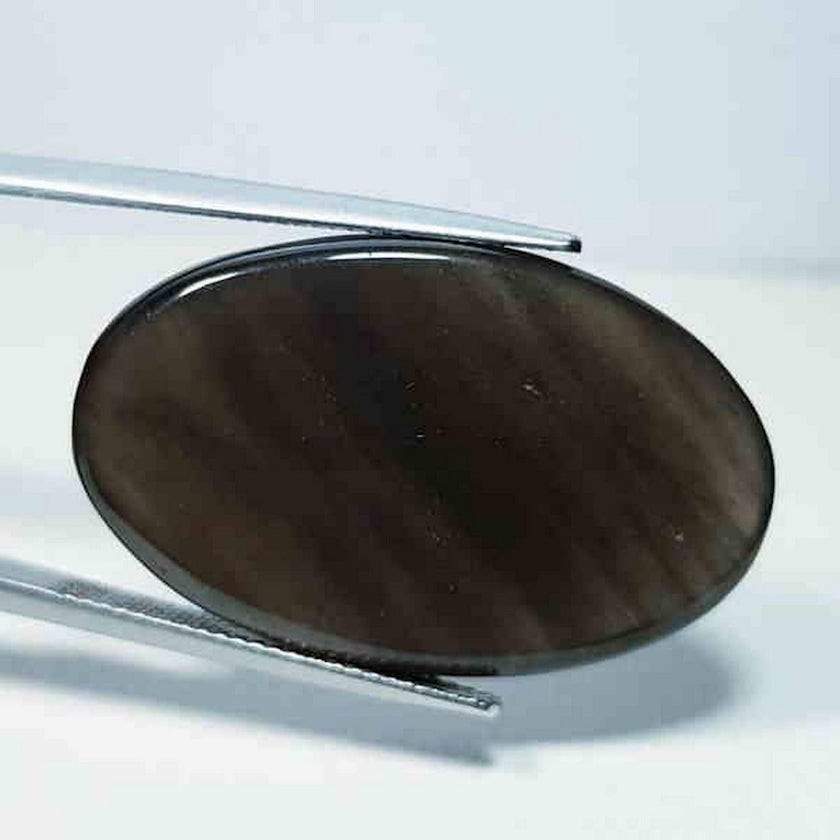 Black obsidian cabochon with a smooth, polished surface
Black obsidian cabochon with a smooth, polished surface
2.2. Snowflake Obsidian: Unique Inclusions, Moderate Value
Snowflake obsidian, characterized by white cristobalite inclusions resembling snowflakes, is moderately priced. Cabochons and beads can range from $5 to $30, depending on size and the clarity of the snowflake patterns.
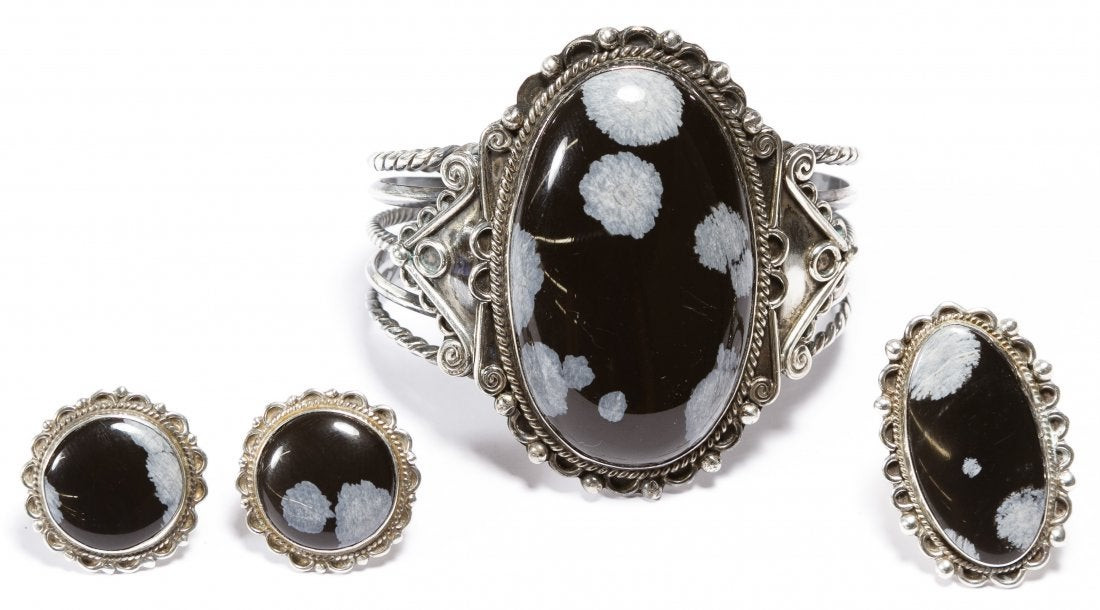 Sterling silver jewelry set featuring snowflake obsidian
Sterling silver jewelry set featuring snowflake obsidian
2.3. Rainbow Obsidian: Iridescent Sheen, Higher Value
Rainbow obsidian, known for its iridescent sheen caused by magnetite nanoparticles, is more valuable due to its visual appeal. Prices range from $20 to $100 or more for larger, well-colored pieces.
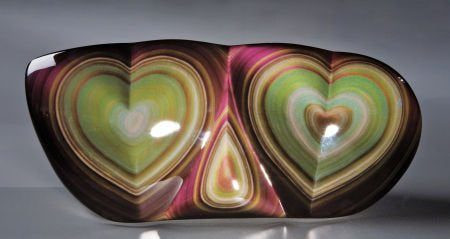 Rainbow obsidian sculpture with a double heart design
Rainbow obsidian sculpture with a double heart design
2.4. Mahogany Obsidian: Reddish-Brown Hues, Moderate Value
Mahogany obsidian, featuring reddish-brown bands due to iron oxide, is another moderately priced variety. Its value is similar to snowflake obsidian, with cabochons and small carvings selling for $5 to $30.
 Mahogany obsidian cabochon showcasing reddish-brown coloration
Mahogany obsidian cabochon showcasing reddish-brown coloration
2.5. Apache Tears: Nodular Form, Sentimental Value
Apache tears, small, rounded nodules of obsidian, have sentimental value tied to Native American legends. They are typically inexpensive, ranging from $1 to $10, often sold as collectible curiosities.
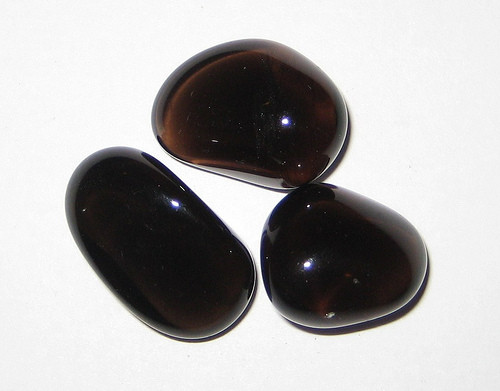 Collection of Apache tears, small, rounded obsidian nodules
Collection of Apache tears, small, rounded obsidian nodules
2.6. Other Varieties and Their Rarity
Other obsidian varieties include gold sheen, silver sheen, and fire obsidian, each with its unique appeal and pricing. The value of these rarer types can vary widely depending on their quality and the intensity of their sheen or color play.
3. What are the Factors That Increase Obsidian’s Value?
Several factors can increase how much is an obsidian rock worth. These include the rarity of the variety, the presence of unique optical effects, the quality of the cut and polish, and historical significance.
3.1. Rarity and Uniqueness of the Obsidian
Rare colors, such as blue, green, or red, significantly increase obsidian value because they are less commonly found in nature. Unique patterns, such as those found in rainbow or fire obsidian, also make a specimen more valuable.
3.2. Quality of Cut, Polish, and Craftsmanship
The quality of the cut and polish is essential for enhancing obsidian’s natural beauty. A well-cut and polished piece will showcase the stone’s luster and any internal patterns, thereby increasing its market value.
3.3. Historical Significance and Provenance
Obsidian artifacts with historical significance or a well-documented provenance can fetch higher prices. For example, obsidian tools or ceremonial objects from ancient cultures are prized by collectors.
3.4. Size and Weight Considerations
Generally, larger pieces of obsidian are more valuable than smaller ones, assuming all other quality factors are equal. The weight and dimensions of the obsidian can impact its use in jewelry or decorative arts, influencing its value.
4. Where Can You Find Obsidian?
Obsidian is found in various locations worldwide, typically in areas with a history of volcanic activity. Key locations include the United States (particularly the western states), Mexico, Iceland, and Japan.
4.1. Major Obsidian Sources Around the World
- United States: Arizona, California, Oregon, and Wyoming are known for different types of obsidian.
- Mexico: A significant source of banded and sheen varieties.
- Iceland: Known for its volcanic landscapes and obsidian deposits.
- Japan: Archaeological sites have yielded obsidian tools dating back thousands of years.
4.2. Best Locations in the USA for Obsidian Hunting
Within the United States, certain locations are particularly renowned for obsidian hunting:
- Glass Buttes, Oregon: Famous for rainbow and fire obsidian.
- Big Obsidian Flow, California: Offers a variety of obsidian types, including black and mahogany.
- Superior, Arizona: Known for Apache tears.
- Yellowstone National Park, Wyoming: Contains obsidian deposits with historical significance.
4.3. Regulations and Permits for Collecting Obsidian
Before collecting obsidian, it’s essential to check local regulations and obtain any necessary permits. Many public lands have rules about collecting rocks and minerals, including obsidian. Disregarding these regulations can result in fines or other penalties.
5. How Is Obsidian Used?
Obsidian has diverse applications, ranging from jewelry and ornamental objects to industrial uses. Its sharp edges made it valuable for creating cutting tools in ancient times, and it continues to be prized for its aesthetic qualities today.
5.1. Obsidian in Jewelry Making
Obsidian is commonly used to create cabochons, beads, and pendants. Its unique patterns and colors make it an attractive choice for jewelry designers.
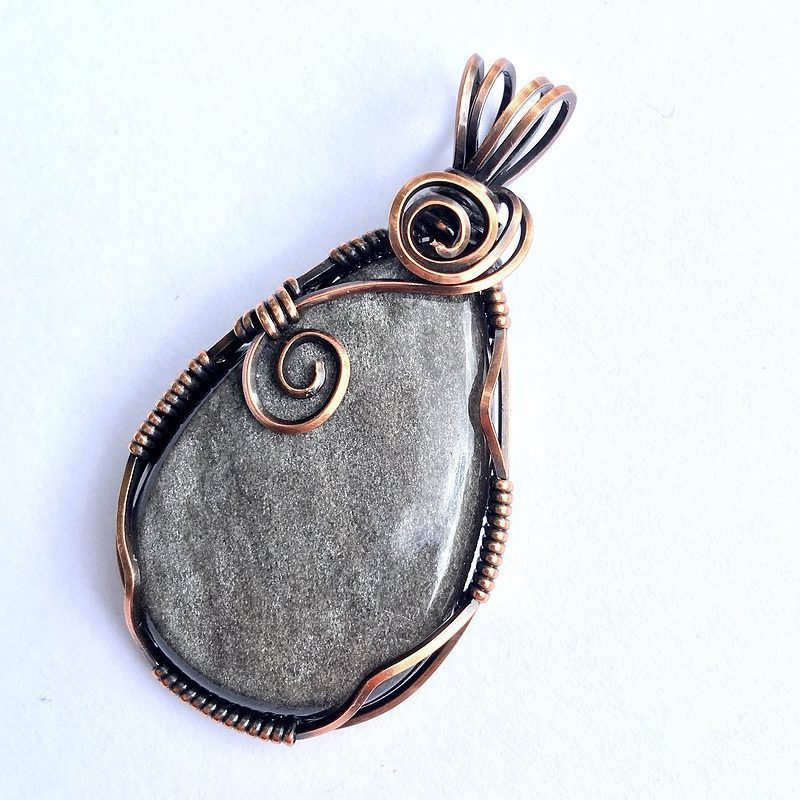 Teardrop pendant crafted from silver sheen obsidian
Teardrop pendant crafted from silver sheen obsidian
5.2. Obsidian in Art and Sculpture
Artists and sculptors appreciate obsidian for its smooth texture and ability to take a high polish. It is often used to create intricate carvings and decorative objects.
5.3. Obsidian as a Cutting Tool
Historically, obsidian was used to make knives, arrowheads, and other cutting tools. Its extremely sharp edges made it superior to many other materials available at the time.
5.4. Obsidian in Landscaping and Decoration
Obsidian can be used in landscaping to add a unique and dramatic element to outdoor spaces. Larger pieces can serve as focal points, while smaller fragments can be used as decorative gravel or mulch. Contact Rockscapes.net to discover inspiration for incorporating landscaping rocks in your project.
6. How to Identify Real vs. Fake Obsidian?
Identifying real obsidian from fake imitations requires careful examination. Key characteristics to look for include the presence of natural inclusions, specific gravity, and refractive index.
6.1. Physical Properties to Look For
- Inclusions: Natural obsidian often contains small inclusions or imperfections.
- Specific Gravity: Obsidian has a specific gravity of around 2.3 to 2.6.
- Refractive Index: The refractive index of obsidian is typically between 1.48 and 1.51.
6.2. Simple Tests to Distinguish Real Obsidian
A simple test involves examining the obsidian under magnification. Natural obsidian may exhibit straight banding and needles, whereas artificial glass is more likely to have a uniform appearance.
6.3. When to Consult a Gemologist
If you’re uncertain about the authenticity of an obsidian specimen, consult a professional gemologist. They can perform advanced tests to determine whether the stone is genuine.
7. How to Care for and Clean Obsidian?
Proper care and cleaning are essential for maintaining the beauty of obsidian. Avoid harsh chemicals and abrasive cleaners, and store obsidian in a safe place to prevent scratches.
7.1. Best Practices for Cleaning Obsidian
Clean obsidian with a soft, lint-free cloth and mild soap. Avoid using harsh chemicals or abrasive cleaners, which can damage the surface of the stone.
7.2. Storage Tips to Prevent Damage
Store obsidian in a soft pouch or jewelry box to protect it from scratches and impacts. Keep it away from other gemstones or materials that could cause damage.
7.3. Avoiding Common Mistakes in Obsidian Care
Avoid exposing obsidian to extreme temperatures or sudden temperature changes, as this can cause it to crack. Also, be cautious when handling obsidian, as its sharp edges can be dangerous.
8. Obsidian and Its Metaphysical Properties
In addition to its geological and aesthetic qualities, obsidian is believed to possess metaphysical properties that promote healing and protection.
8.1. Beliefs and Legends Associated with Obsidian
Obsidian is often associated with grounding, protection, and emotional healing. Some believe it can help release negative energy and promote clarity.
8.2. Obsidian in Healing and Spiritual Practices
In various spiritual practices, obsidian is used as a tool for meditation, scrying, and energy work. It is believed to enhance intuition and promote self-discovery.
8.3. The Psychological Impact of Owning Obsidian
Some people find that owning obsidian helps them feel more grounded, secure, and protected. Its dark, glassy appearance can be both intriguing and calming.
9. The Future of Obsidian: Trends and Predictions
The future of obsidian in the market looks promising, with increasing interest in its use in jewelry, art, and landscaping.
9.1. Emerging Trends in Obsidian Use
One emerging trend is the use of obsidian in modern architecture and interior design. Its unique texture and color can add a sophisticated touch to contemporary spaces.
9.2. Market Predictions for Obsidian Value
As demand for unique and natural materials continues to grow, the value of obsidian is likely to increase. Rare varieties and high-quality specimens will likely command the highest prices.
9.3. Sustainable Sourcing and Ethical Considerations
With growing awareness of environmental issues, sustainable sourcing and ethical mining practices are becoming increasingly important. Consumers are more likely to seek out obsidian from responsible suppliers.
10. Frequently Asked Questions (FAQs) About Obsidian Value
10.1. What is the most expensive type of obsidian?
Rainbow obsidian is generally considered the most expensive type of obsidian due to its iridescent sheen caused by magnetite nanoparticles.
10.2. How can I tell if my obsidian is real?
Examine the obsidian for natural inclusions, check its specific gravity (around 2.3 to 2.6), and look for straight banding or needles under magnification.
10.3. Is obsidian considered a gemstone?
Yes, obsidian is considered a gemstone, although it is technically a volcanic glass rather than a crystal.
10.4. Where is obsidian most commonly found?
Obsidian is most commonly found in areas with a history of volcanic activity, such as the western United States, Mexico, Iceland, and Japan.
10.5. Can obsidian scratch glass?
Obsidian has a hardness of around 5.5 on the Mohs scale, which is lower than that of glass (around 6 to 7). Therefore, obsidian cannot scratch glass.
10.6. What are the metaphysical properties of obsidian?
Obsidian is believed to have metaphysical properties that promote grounding, protection, and emotional healing.
10.7. How should I clean my obsidian jewelry?
Clean obsidian jewelry with a soft, lint-free cloth and mild soap. Avoid harsh chemicals and abrasive cleaners.
10.8. What is snowflake obsidian used for?
Snowflake obsidian is commonly used in jewelry making to create cabochons, beads, and pendants.
10.9. Is it legal to collect obsidian from public lands?
It depends on the location and local regulations. Check with the relevant authorities before collecting obsidian from public lands.
10.10. How does the size of obsidian affect its value?
Generally, larger pieces of obsidian are more valuable than smaller ones, assuming all other quality factors are equal.
Obsidian rock worth is influenced by a combination of geological factors, aesthetic qualities, and market dynamics. Whether you’re a collector, jewelry maker, or landscaper, understanding these factors can help you appreciate and assess the value of this fascinating volcanic glass.
Ready to explore the beauty and versatility of obsidian for your next landscaping project? Visit Rockscapes.net today to discover a wide selection of obsidian and other natural stones, along with expert advice and design inspiration. Transform your outdoor space with the timeless elegance of natural stone. Contact us at Address: 1151 S Forest Ave, Tempe, AZ 85281, United States, or call +1 (480) 965-9011. Let rockscapes.net help you bring your vision to life!